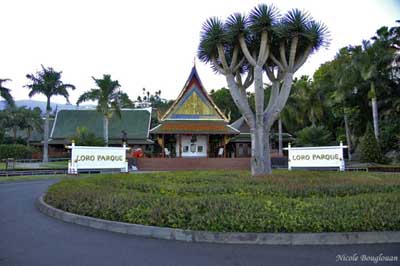
LORO PARQUE FOUNDATION AND PARROTS
Tenerife Island (Canary Islands-Spain) shelters at the edge of its northern coast a superb park where hundreds of parrots from around the world live. Since its creation and opening to the public in 1972, Loro Parque has improved a little more each year: increase of the area, arrival of other animals (terrestrial mammals, reptiles, dolphins, sea lions, killer whales ...), creation of an ice-field with observation of King Penguins, Gentoo Penguins, Chinstrap Penguins, and Rockhopper Penguins, installation of the habitats for the big cats, gorillas and, of course, the presence of birds within tropical gardens where many exotic plants grow.
We must arrive to the park with our child’s soul and the desire for discovering. The beautiful entrance, exuberant vegetation, colours, perfumes, bird’s calls, this whole combination helps us to immerse within an atmosphere which carries us away, elsewhere, so far, and it is better for us to accept it.
The Loro Parque Foundation works in this way, by constituting "reserves" in order to reintroduce these wonderful birds into wild after having given them the chance to be born within good conditions. Let us wish them a good come back in their wet and shadowy forests, where their life is, and where our duty is to protect them.
Photographers:
Patrick Ingremeau
TAMANDUA
Marc Chrétien
MURINUS
Alfredo Colón
Puerto Rico Wildlife
Text and pictures by Nicole Bouglouan
From observations at the Loro Parque Foundation – Tenerife – Canary Islands
Other links :

Bright-coloured parrots are installed in large aviaries along the track which snakes among all kinds of palm trees. Very attentive caretakers are working around and within the cages. Care is very important and plays an essential part in the conservation of the species present in the park.
This very large area created over 13,5 hectares at the edge of the sea, shows us an exuberant and healthy nature, respected and protective of its inhabitants. Some people say that this kind of area, almost perfect, seems to show to humans their failure, their incapacity to preserve vital assets, their incompetence to protect the environment. Yes, it is true. By seeing this park, it is normal to think it would be wonderful to find again these landscapes in their original countries.
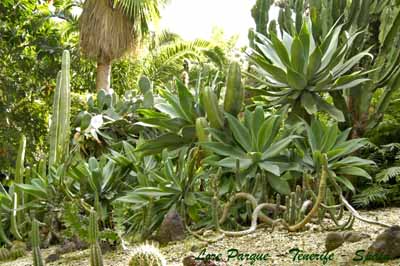
Unfortunately, numerous species are in decline, some of them are endangered, others are already extinct. Why? The question is useful, but the answers are always the same!
If natural disasters are of course to be taken into account in the species’ disappearance, we must not forget the other reasons. Heavy deforestation for agriculture, drainage of wetlands, human developments, urbanization, disturbances at nesting sites by noisy and destructive aerial, aquatic or terrestrial activities, persecution of some species, varied pollutions... The result is not too good, and improvements are long in coming. So, animals are disappearing, through lack of appropriate habitat, healthy food, and space obviously.
That is why, behind Loro Parque’s beauty and splendours, there is the Loro Parque Foundation, created in 1994. The Spix’s Macaw (Cyanopsitta spixii) is chosen as the Foundation symbol. This species is among the most threatened in the world, living in restricted forest galleries in north-east Brazil. During the fifty last years, the Spix’s Macaw declined, due to illegal trade, hunting and habitat loss. The last wild macaws have been captured and are now protected in captivity. The last wild Spix’s Macaw disappeared in 2000.
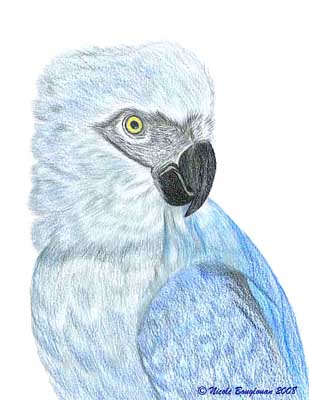
Since 1990, the Foundation Loro Parque Foundation has collaborate in and financed the conservation project in the lowlands close to river Sao Francisco, an area which potentially could shelter a future viable population of this species.
Currently, 78 Spix’s Macaws are living in captivity, and the latest reward came in January 2007 to Loro Parque Foundation, with the very much awaited birth of a Spix’s Macaw, a female in good health. The most charismatic of nestlings finally came into the world, giving again hope to the more sceptical! Loro Parque Foundation maintains, on behalf of the Brazilian Government, one breeding pair which produced two females in 2004, and one more in 2006.
Future breeding will be tried according to recommendations of the international studbook, in order to bring new blood.
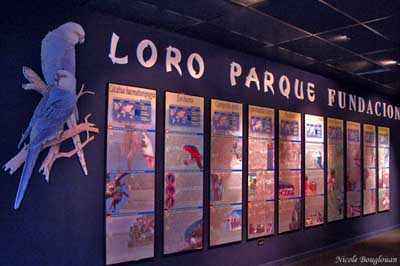
Again another success today, result of several years of work, the success of Yellow-eared Conure (Ognorhynchus icterotis) reproduction in Colombia. This conure was listed as a critically endangered species because its nesting habitat rapidly disappeared. This bird is closely related to the Wax Palm (Ceroxylon quindiuense) for feeding and nesting, and declined in a dramatic way due to deforestation and hunting. In order to stop it, the Loro Parque Foundation has since 1999 financed an extensive conservation programme, including the rehabilitation of suitable nesting sites for this species.
Already in 2001, another population had been discovered in the Andes, appreciably increasing the rather restricted numbers of these conures. But also, in order to continue the increase, artificial nest-boxes were installed in 2003 to prevent the lack sooner or later of cavities, because the Wax Palm is also threatened with extinction. Even if it is now forbidden to cut it down, they are very few.
Today, in 2007, thanks to the close cooperation of Loro Parque Foundation of Tenerife and ProAves Foundation of Colombia, between the natural cavities offered by dead Wax Palm trees and artificial nest-boxes, the Yellow-eared Conure has bred successfully, making possible new hope. We currently have more than 600 birds of this species in Colombia.
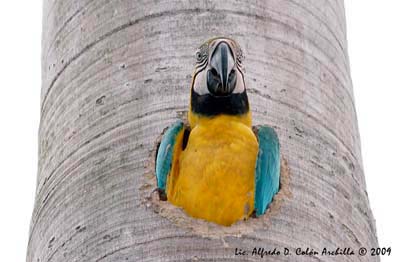
But this is only one example among so many others. The essential purpose of Loro Parque Foundation is to protect parrots and their habitats by financing actions in the field and breeding programs, and by purchase of lands where endangered species maybe will be able to succeed in surviving while reproducing in a suitable habitat.
Why parrots? They are difficult to miss in the world! Obviously because a parrot, by its bright colours, its touching or comical expressions, and its easy contact with humans, is a bird which enchants us! Communication is quickly established with a little patience. The simple fact of photographing them in wild gives a gleam of interest in their eyes. Wary but curious, shy but gregarious, these birds charm us immediately.
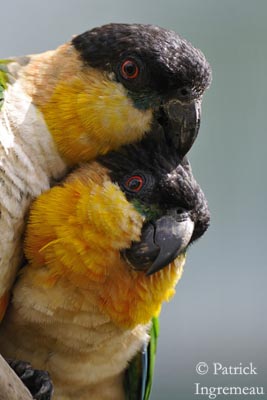
But unfortunately, it is in the Psittacidae that we find the greatest number of endangered species.
These wonderful birds are living in regions were habitat loss is almost daily. It is why Loro Parque Foundation takes part in preservating, among the most endangered ecosystems in the world.
This conservation works is made in diverse ways including environmental education, ecological studies, parrot population management and their reintroduction into protected and suitable habitat.
But also due to their beauty, parrots are very popular cage birds, and are trapped and caught for trade. Young are removed from the nest to keep in captivity for the pleasure of humans. People don’t realize the damage and consequences caused by their passion for these species. Parakeets, parrots, lorikeets, amazons and others, attract with their beautiful plumage, their comical expressions and their almost human countenance.

From only talking about it, the wonderful Hyacinth Macaw is killed for its feathers, used for making hats for tourists in Brazil! Ten Hyacinth Macaws are necessary for only one hat…
The abuses are uncountable, and in spite of protection, illegal trade is going on and this species is now endangered.
But Loro Parque Foundation’s action is beginning to bear fruit. The trade in parrots is gradually including more birds reared in captivity, reducing trapping and direct impact on wild species. The Loro Parque Foundation uses the resources from sales of captive bred-parrots for financing action in the field, for preservation and conservation of habitats, and of course, of their inhabitants. When only one species is saved, its environment and the others inhabitants are saved too.
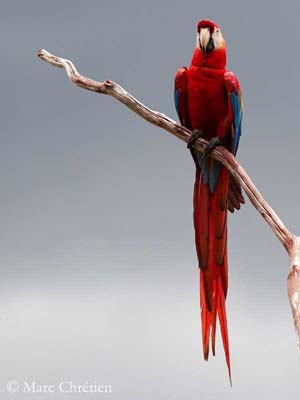
This is why Loro Parque Foundation is working hard for constituting, caring and conserving a solid genetic reserve, in order to have enough individuals in good health to reintroduce them into their native countries, hoping they will breed again in the wild.
Captive birds kept for these projects are accommodated in large aviaries. They live in groups and can choose their mates. Return to living wild is easier, although nothing is certain.
To visit the Loro Parque Foundation’s breeding centre is a rare and unforgettable experience. The professionalism of the people working there is impressive. It is here we begin to understand why so many parakeets, parrots, lorikeets and others suffer as much in captivity in private homes. Everything is important, from the cage size, through to the ambient temperature, cleanliness of the cage, and the food. Some of the parrots consume fruit and nectar, others eat seeds, without speaking about lorikeets which consume only worms during the breeding and nesting season, whereas they hardly touch them the rest of the time!
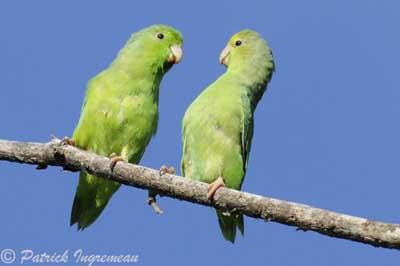
Food is carefully prepared, weighed, sorted, and chosen according to each species. All utensils are is very clean and meals are worked out by a head chef worthy of the best restaurants. Cleaning of cages is regular, scrupulous and daily of course.
Here, in the breeding centre, all is done for each species to be fine and to live and breed within the best conditions. Cages are adapted to each species or family. Vegetation covering two sides of the cages is adapted to bring more to parrot’s lives. Composed of nontoxic plants, it passes through the cage’s mesh while growing, and at this moment each occupant becomes his own gardener, chewing and nibbling at leaves and sticks and consuming the flowers.
During the nesting period, the birds keep the whole foliage in order to hide the nest in the depth of the cage, behind a green protection. As soon as the young leave the nest, they chew and eat all within reach and the landscape changes again.
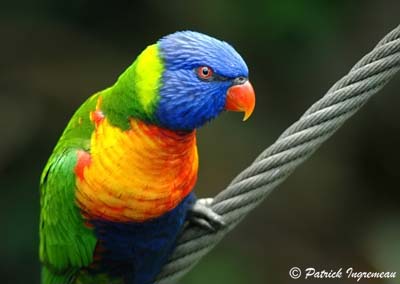
The ground is strewn with gravel of volcanic origin, used as temperature regulator. If the atmosphere becomes too dry, showers fixed at the top of the cages allow wetting this special substrate which stores the water and returns it into the cage in order to give the necessary humidity to these birds. In the same way, if temperature becomes too high, the parrots benefit from these showers to refresh them.
The areas where cages are aligned are protected by fine mesh nets having several functions. First, they avoid predator intrusions such as birds of prey, or other external birds which could bring diseases and parasites, and they also provide shade and temperature control.
The place is well monitored day and night, but alas, thieves nevertheless manage to steal parrots, selected with precision according to sex and age. One could wax eloquent about the goal of these thieves...

The reproduction of the parrots is closely managed. Some species breed well and the parents raise their young themselves. In these cases, they are already older pairs. Unfortunately, young inexperienced parents are often helpless in front of their chicks and they can’t raise their young themselves. The breeding centre takes over from the pair and raises the young, or, surprisingly, entrusts them to another pair, not necessarily of the same species, and which will raise them in a more natural way than in the hand. Know-how and experience of professionals are essential in order to choose the best moment to entrust these young to foster parents who, if not, obviously reject and kill them.
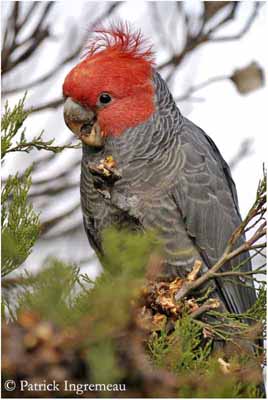

Currently, in 2007, two young Gang gang Cockatoos (Callocephalon fimbriatum) have been raised in the breeding centre creche, while two other young of the same species have been raised by their adoptive parents, a Pink Cockatoo pair (Cacatua leadbeateri). In addition, a Gang gang Cockatoo pair has raised its own young.
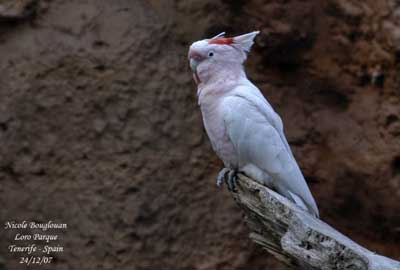
Then, the young parrot needs to socialize itself, and for this reason, it lives for some time in a large cage with other parrot species. This communal life teaches it the fundamental rules of everyday life. If it is aggressive, it will calm down in contact with those more powerful than him, it will find also a mate and a pair will form and it will defend its territory without unhealthy or disproportionate aggressiveness against the other birds present in the same cage. It is perhaps what we name education in humans...
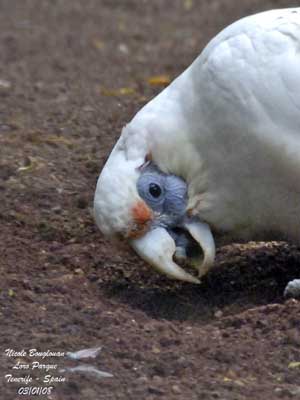
To conclude, let us return to the Spix’s Macaw, symbol of Loro Parque Foundation. Two beautiful young females are visible in the breeding centre. The breeding pair will be transferred soon into a separated facility very well protected from potential pathogens. This pair under Brazilian ownership has for the moment given four young females. Fortunately, repeated contacts with other centres and private collections will allow common actions, with exchanges or loans of mates in order to help other pairs to breed and to bring new blood to this species. All the hope, to see one day this such beautiful bird free in its native gallery forest in Brazil and to reproduce there, resides on the success of these closely managed programs, and on the protection and regeneration of its habitat in its native country.
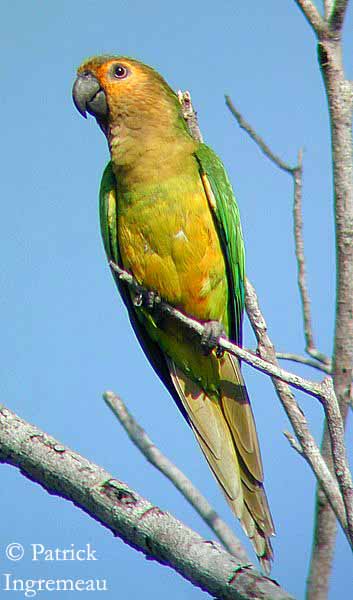
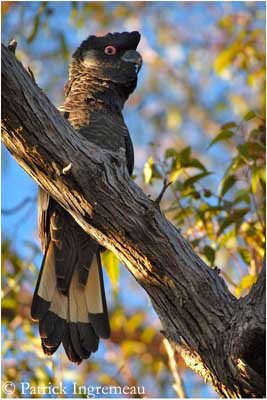
Let us think in future before buying a parrot or a lorikeet, or a parakeet with wonderful colours, all that this bird will represent constrained, even if it gives much pleasure to its owner. It needs much care to live in good conditions, and even if the fact of being in your home represents for it an effective protection against all kinds of predators, it will never feel as fine as in its native habitat. All species are not endangered, fortunately, and to see them flying from tree to tree in coloured and noisy flocks in suitable areas is also an attractive show, because nothing is as wonderful as freedom!

Male (R) and Female (L)